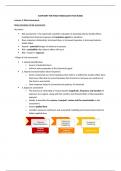SUMMARY FOR FOOD TOXICOLOGY (TOX-30306)
Lecture 2: Risk Assessment
Basic principles of risk assessment
Key terms
Risk assessment = the systematic scientific evaluation of potential adverse health effects
resulting from (human) exposure to hazardous agents or situations
Dose-response relationship= Increased dose, is increased response, is increased adverse
health effect
Hazard = potential danger of chemical or process
Risk = probability that adverse effect will occur
Risk = hazard + exposure
4 Steps of risk assessment
1. Hazard identification
o Source of potential harm
o Intrinsic toxic properties of the (chemical) agent
2. Hazard characterisation (dose-response)
o Some compounds are more hazardous than others, is defined by median effect dose,
how lower that dose he more hazardous the chemical is, because you need less of
the dose to see toxicity
o Dose-response helps to characterize he potency of chemicals
3. Exposure assessment
o The process of estimating or measuring the magnitude, frequency and duration of
exposure to an agent, along with the number and characteristics of the population
exposed
o Ideally, it describes the sources, transport, routes and the uncertainties in the
assessment
o Assess applied dose
o Consider exposure continuum and associated modelling and measurement tools to
define applied dose
, 4. Risk characterisation
o Probability of an adverse outcome based upon the exposure and potency of (a)
hazardous agent(s)
4.1 Risk management
o The process of identifying, evaluating, selecting and implementing scientifically
sound, cost-effective, integrated actions to reduce risk to human health and
ecosystems while taking into account social, cultural, ethical, economical, political
and legal considerations
4.2 Risk communication
Risk management vs risk assessment
What is a hazardous agents?
In toxicology focus on chemicals, but can also be biological or physical hazard
Regulatory Agencies Performing Risk Assessments
European Medicines Agency
European Food Safety Authority
European Chemicals Agency
,Discriminate between 2 types of chemicals
1. Non-genotoxic chemicals
2. Genotoxic chemicals (chemicals causing DNA damage)
Type of risk assessment dependent on type
Risk assessment of non-genotoxic chemicals
Risk assessment non-genotoxic chemicals in food
Non-genotoxic compounds have defined
threshold (safe level of exposure) e.g. receptor
inhibition
Median effective dose (EC50) = for comparing
chemical potency
Lowest Observed Adverse Effect Level (LOAEL)
= lowest tested dose at which adverse effect
was observed
No Observed Adverse Effect Level (NOAEL) =
Highest tested dose at which no adverse effect
was observed
Toxicity testing scheme
Chemical characterization: What type of chemical is it?
Literature review: What information is already there?
Structure-Activity Assessment: What does the compound look like?
(Sub)Acute Toxicity: Test exposing animals with an increasing (single) dose and observe what
happens
Sub chronic Toxicity: give animal chemical at certain dose for 90 days, NOAEL and reference
dose established
Chronic Toxicity: give animals compound for entire life time and see what happens
Reproductive/ Teratology: Give chemical for entire life time and look at the reproductivity
Oncogenicity: What potential is there for the chemical to produce tumour formation
, Choice of Dose-response relationship
Dose response relationship for target organ (i.e., most sensitive organ)
Which dose response to start with? Response at lowest dose, and most critical effect which is
clinically relevant.
Reference Dose (RfD) setting
Establish causality that the chemical has in fact induced the observed effects
Establish NOAEL, LOAEL (to ID point of departure, POD)
Determine rate at which injury builds up: slope of dose response curve
Apply uncertainty factors
Uncertainty Factors (UF) in RfD setting
UF = Uncertainty/safety factors used to extrapolate from a group of test animals to an
average human and from average humans to potentially sensitive sub-populations
RfD = NOAEL / / other UFs quality of data type exposure
Toxicokinetics vs toxicodynamics
Dynamics = What the chemical does to the body
Kinetics = What the body does to the chemical Absorption, Distribution, Metabolism,
Excretion
ADI vs TDI
Reference doses determined by EFSA to indicate doses of chemical which we can safely be
exposed to daily
ADI = Acceptable daily intake (voluntary exposure)
TDI = Tolerable daily intake (involuntary exposure)




